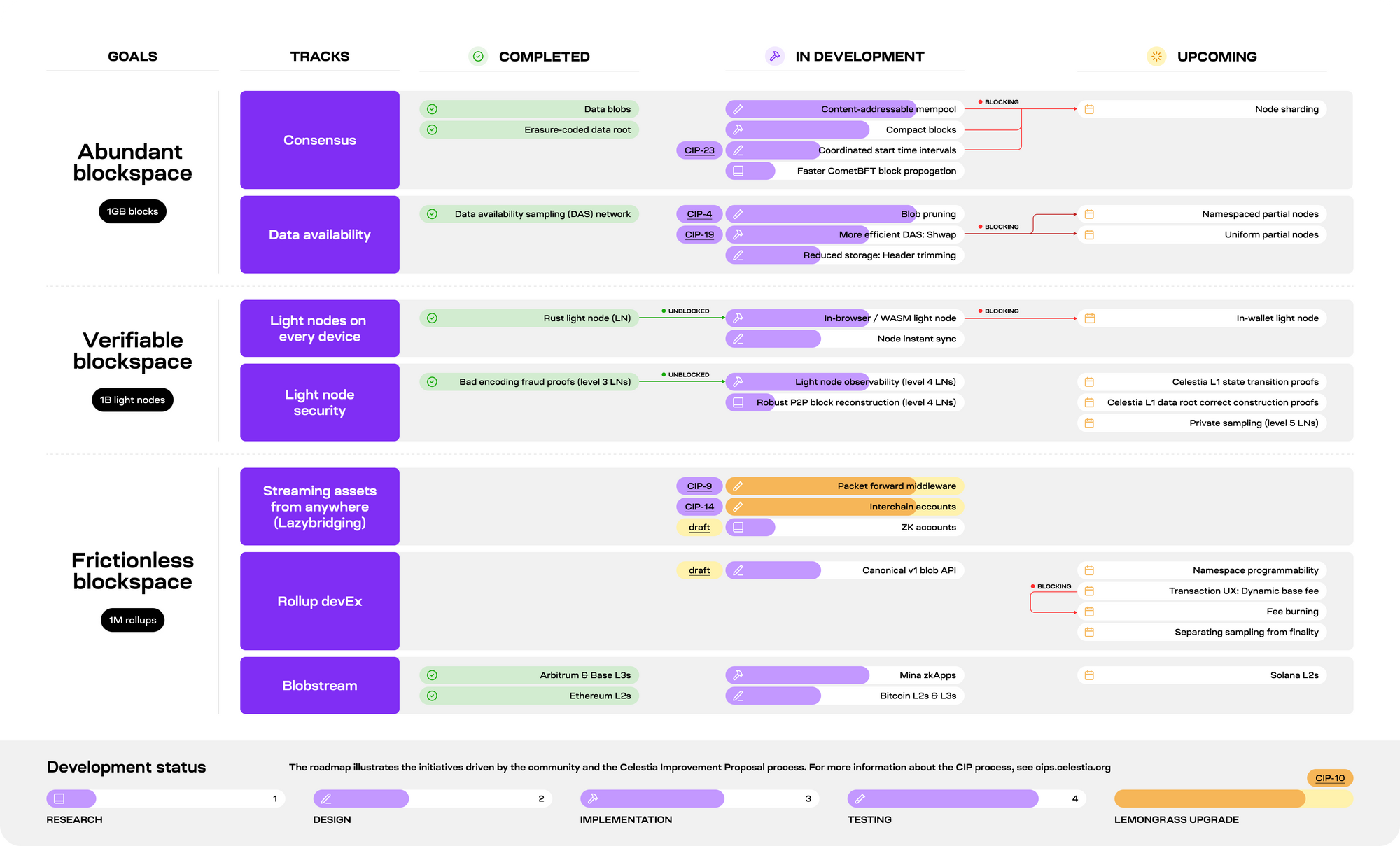1 GB blocks to Build Whatever

After several years of development, Celestia Mainnet Beta went live last year. Since then, an early ecosystem has taken form, with developers deploying the first 20 rollups and Celestia blobs represent 40% of total data published.
Alongside growth of the early ecosystem, Celestia’s core developer community has been working on the protocol's next phase, with 16 public core developer calls and an active ZK working group with participants from many teams. The community has already drafted or proposed 24 Celestia Improvement Proposals (CIPs), representing six different core dev entities.
The core devs are preparing the first major upgrades, starting with Lemongrass, and now present a technical roadmap with contributions from multiple teams.
Scaling to 1 Gigabyte blocks
The community’s roadmap has a core objective: relentlessly scale to 1 gigabyte blocks, bringing a massive increase in data throughput to Celestia’s rollup ecosystem.
Before Celestia, scaling permissionless blockchains has typically meant optimizing a monolithic L1 in terms of consensus or the execution of a single VM.
But Celestia is not constrained by execution layer overhead or state bloat, enabling a roadmap to scale throughput beyond current monolithic constraints. And developers are not confined to a single smart contract language, virtual-machine, or even a rollup framework.
Instead, developers can build whatever.
With Celestia underneath, developers can deploy high-throughput, unstoppable applications using any VM, whether to scale existing ecosystems like Ethereum or as their own sovereign networks.
High-throughput DA already accelerates established crypto applications, enables Web2-like latency for end users, and makes alt-VM L2s more performant than their monolithic L1 counterparts.
In a previous era, the transaction throughput of Visa (~24,000 TPS) was considered a worthy destination of any scaling roadmap. A world-scale computer was imagined to be very far in the future.
By relentlessly focusing on DA, massive throughput gains are now within reach simply by increasing the block size. A mix of technical innovations on the roadmap are paving the way to 1 gigabyte blocks, including a content-addressable mempool, compact blocks, optimizing CometBFT block propagation, internally sharding nodes, and an improved data availability sampling protocol.
With 1 gigabyte blocks, Celestia will deliver the capacity of many Visa networks in parallel. This unlocks onchain applications and capabilities that were previously considered unviable, with enough throughput to enable verifiable web apps and fully-onchain worlds.
Verifiable by anyone, on any device
Forcing users to rely on trusted, black-box APIs undermines the purpose of crypto applications in the first place. The community is working to make the light node run in web browsers, so that applications deployed in Celestia blockspace are verifiable by anyone, on any device.
Anyone can try an early version of the light node in the browser, built by Eiger at Lumina.rs today.
Overview

The roadmap is structured following this vision and is organized into three main workstreams:
1. Abundant Blockspace: The aspiration to achieve 1GB blocks ensures Celestia has enough capacity to scale to a large number of diverse rollups, even for throughput-hungry use-cases like many Visa-scale payment networks, fully-onchain games, high-throughput DeFi. Unlocking true scalability and cheap transaction fees for end users. There are two core tracks to scaling up DA throughput:
- Consensus: Optimizes the consensus network of Celestia for maximum throughput enabling the production of larger blocks to give users access to abundant blockspace.
- Data availability: Improves the data availability network of Celestia to enable sampling and reconstruction of larger blocks, while lowering resource requirements for various node types. This gives users the option to run nodes on low-resourced devices or in their wallets in the background.
2. Verifiable Blockspace: Ensures that blockspace is verifiable by anyone, anywhere, on any device, allowing users to directly verify the correctness of blockspace secured by Celestia.
- Light nodes on every device: Brings light nodes to every device and end user wallets. This enhances their security, and reduces reliance on third-party committees or centralized infrastructure.
- Light node security: Minimizes the trust assumptions for end-users and node operators alike giving them higher security guarantees.
3. Frictionless Blockspace: Focuses on removing any friction for rollup developers and end-users alike. This goal is split into three tracks:
- Streaming assets from anywhere (Lazybridging): Improves interoperability between rollups on Celestia and the base layer itself, addressing the modular fragmentation problem.
- Rollup developer experience: Aims to achieve the best possible developer experience for rollup developers.
- Blobstream: Scales any ecosystem by streaming Celestia’s data attestations to another L1.
Explore the Roadmap today
To help you navigate the technical features and initiatives mentioned in the roadmap, we have compiled a comprehensive glossary. Explore it here.
Community and Governance
The Celestia community drives all updates and initiatives through the Celestia Improvement Proposal (CIP) process. Learn more about the CIP process and current in-progress CIPs here. This is an open process and the discussions around it are all accessible publicly. Anyone from the community can weigh in and participate.
Get involved
Stay tuned for more updates as the Celestia community continues to innovate. Join the discussion and contribute to Celestia’s future today!